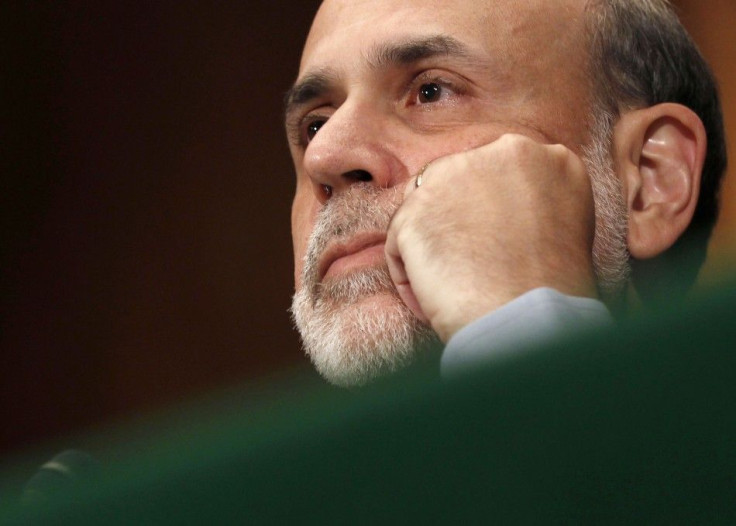With Europe Plan in Place, All Eyes Turn to Fed
ANALYSIS

On the heels of the Eurozone debt -- European leaders' decision to increase their bailout fund to €1 trillion or $1.4 trillion and encourage banks owning Greek debt to accept at 50 percent loss (haircut), investor attention turns to the U.S. Federal Reserve's next move: is a stand-pat stance likely or is quantitative easing, part 3 (QE3) on the way?
Inflation Hawks' Argument
On one side are the inflation hawks, who argue that the Fed's quantitative easings -- QE, QE2 and Operation Twist -- have done little to stimulate end-market demand, called aggregate demand by economists, while simultaneously triggering an economic negative: higher inflation.
Moreover, the rate of inflation has increased in the past 12 months, up to a 3.9 percent rate, with a 2.0 percent rise in the core rate (which excludes food and energy prices). That's up from a top-line rate of 1.7 percent and a core rate 0.9 percent nine months ago, in January 2011.
Clearly, the inflation hawks on the Fed argue, the unconventional quantitative policies have boosted inflation, and prolonging the policy(ies) -- or at least maintaining them at the same size -- will feed more inflation into the system. Now is the time to start removing quantitative easing, the hawks say.
Price Doves' Argument
Not so fast say the Fed's doves.
The reason? The U.S. economy has already slowed to a crawl. Add the asset destruction / wealth destruction (also called the negative wealth effect) that occurs when the stock market drops about 1,000 points, and the economy could slow even more, perhaps tipping back into a recession.
Don't misunderstand, U.S. Federal Reserve Chairman Ben Bernanke, who understands full well the relationship between the wealth effect and the economy, will not implement QE3 solely to increase asset prices, but if the declines are such that both balance sheets and liquidity are damaged to significant degree, Bernanke may conclude that implementing QE3 is prudent.
Institutional Investors: Some Have Factored-In QE3
Further, some institutional investors have already discounted -- or factored-in -- QE3.
With short-term interest rates already near zero, these investors say another $500 billion to $700 billion in asset purchases by the Fed as part of a QE3 is likely in the next six months.
About one year ago the Fed implemented QE2 when it became clear the economy, due to a lack of demand, was in danger of falling into a vicious cycle of declining revenue, and declining prices -- the dreaded deflationary spiral.
Deflation, a protracted, systematic decline in prices, robs companies of revenue and can lead to the dreaded 'deflationary spiral, in which price cuts lead to lower corporate revenue, prompting more lay-offs, leading to further consumer spending declines, prompting more price cuts, and so on. Hence, deflation would hurt most corporations' top line, and that would weigh on the stock market.
Right now, the deflation risk is low, with most economists interpreting the current U.S. consumer price condition as one of low inflation.
Which Side Will Prevail: Hawks or Doves?
That said, as noted, with the 12-month, year-over-year consumer price index (CPI) inflation running at 3.9 percent -- a rise from the disinflation of a year ago -- and the Fed's inflation hawks will have more than enough evidence to make their argument that a third round of quantitative easing will increase inflation to unacceptable levels.
Conversely, the Fed's price doves will argue that with the U.S. unemployment rate at an unacceptable 9.1 percent, median incomes stagnant in many job segments, the U.S. economy operating well below its output potential, and now with asset destruction stemming from the Eurozone's mandatory Greek bonds mark-down, inflation will, if anything, moderate in the immediate quarters ahead. The greater risk, the doves argue, concerns the U.S. economy tipping back into a recession, following the worst recession since the Great Depression.
Monetary/Economic Analysis: The view from here argues the following: look for Bernanke to deploy a partial QE3, if the economy does not record at least 2.5 percent GDP growth in the fourth quarter -- historically a good quarter for commerce in the United States. The U.S. economy grew at a 2.5 percent rate in the second quarter.
Until then, more than likely Bernanke will note the recovery slowdown, outline that the recovery is still not at a sufficient growth rate, and underscore that the Fed remains prepared to take additional action if deflation pressures emerge or if the economy slows further.
What could really benefit the economy -- and make Bernanke's job easier? A GDP tailwind from a substantial fall in oil prices. And the U.S. economy may get just that, assuming Libya oil production starts to increase following the ouster and passing of Leader Moammar Gadhafi: Libyan output ran at one-tenth its 1.8 million barrel per day average during the civil war.
© Copyright IBTimes 2024. All rights reserved.





















